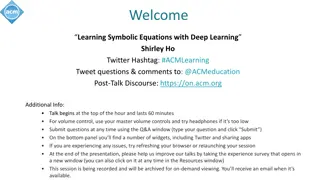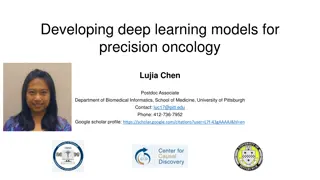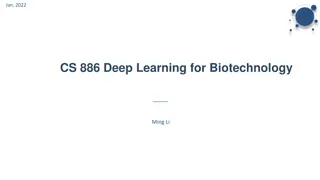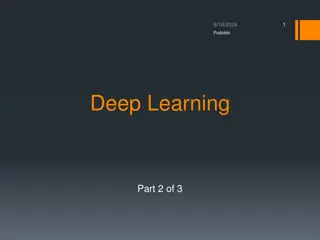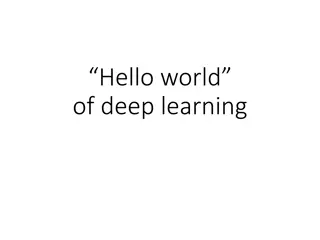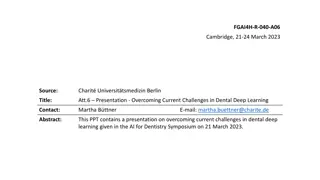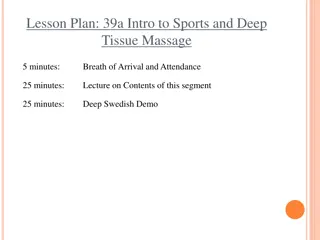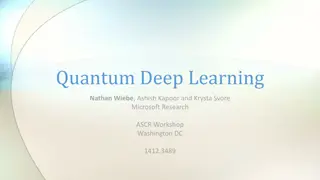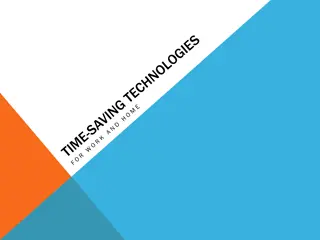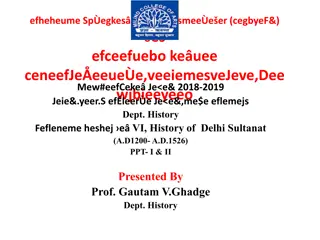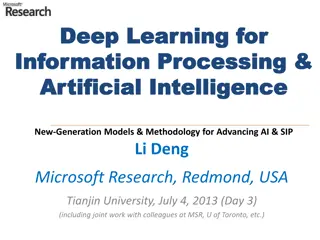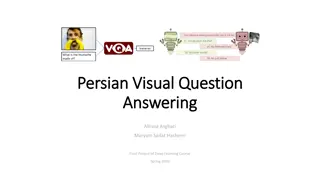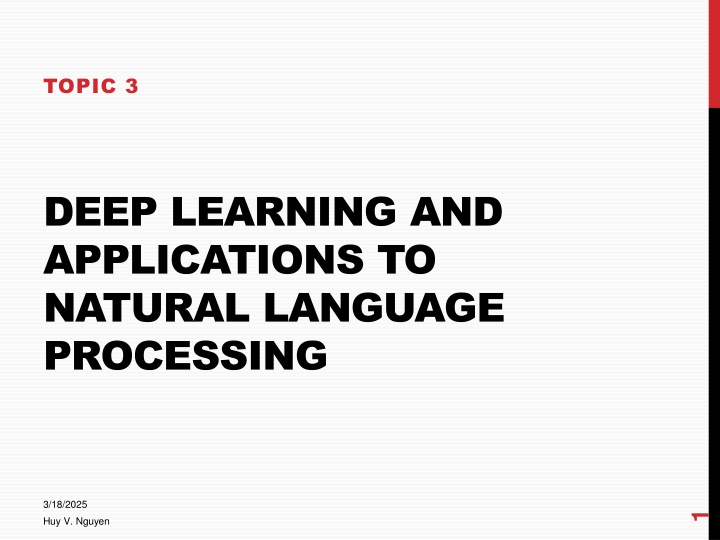
Deep Learning Applications in Natural Language Processing
Explore the intersection of deep learning and natural language processing, covering topics such as deep vs shallow architectures, representation learning, breakthroughs in learning principles, and the success of deep learning in NLP applications. Delve into the advantages and concerns associated with deep learning techniques and architectures, highlighting the importance of representation learning for feature extraction and classification in NLP tasks.
Uploaded on | 7 Views
Download Presentation

Please find below an Image/Link to download the presentation.
The content on the website is provided AS IS for your information and personal use only. It may not be sold, licensed, or shared on other websites without obtaining consent from the author. If you encounter any issues during the download, it is possible that the publisher has removed the file from their server.
You are allowed to download the files provided on this website for personal or commercial use, subject to the condition that they are used lawfully. All files are the property of their respective owners.
The content on the website is provided AS IS for your information and personal use only. It may not be sold, licensed, or shared on other websites without obtaining consent from the author.
E N D
Presentation Transcript
TOPIC 3 DEEP LEARNING AND APPLICATIONS TO NATURAL LANGUAGE PROCESSING 3/18/2025 1 Huy V. Nguyen
OUTLINE Deep learning overview Deep v. shallow architectures Representation learning Breakthroughs Learning principle: greedy layer-wise training Tera scale: data, model, resource Deep learning success Deep learning in NLP Neural network language models POS, NER, parsing, sentiment, paraphrase Concerns 3/18/2025 2 Huy V. Nguyen
DEEP V. SHALLOW OVERVIEW (Bengio 2009, Bengio et al. 2013) Human information processing mechanisms suggest deep architectures (e.g. vision, speech, audition, language understanding) Input percept is represented in multiple-level abstraction Most machine learning techniques exploit shallow architectures (e.g. GMM, HMM, CRF, MaxEnt, SVM, Logistic) Linear models cannot capture the complexity Kernel tricks is still not deep enough Unsuccessful attempts to train multi-layer neural networks for decades (before 2006) Feed-forward neural nets with back-propagation Non-convex loss function, local optima 3/18/2025 3 Huy V. Nguyen
DEEP LEARNING AND ADVANTAGES Wide class of machine learning techniques and architectures Hierarchical in nature Multi-stage processing through multiple non-linear layers Feature re-use for multi-task learning Distributed representation (information is not localized in a particular parameter likes in one-hot representation) Multiple levels of representation Abstraction and invariance More abstract concepts is constructed from less abstract ones More abstract representation is invariant to most local changes of input 3/18/2025 4 Huy V. Nguyen
REPRESENTATION LEARNING Representation learning (feature learning) Learning transformation of the data that make it useful information for classifiers or other predictors Traditional machine learning algorithm deployment Hand-crafted features extractor + simple trainable classifier Inability to extract/organize the discriminative info. from data End-to-end learning (less dependent on feature engineering) Trainable feature extractor + trainable classifier Hierarchical representation for invariance and feature re-use Deep learning is to learn the intermediate representation Its success belongs to unsupervised representation learning 3/18/2025 5 Huy V. Nguyen
ENCODER DECODER A representation is complete if it is possible to reconstruct the input from it Unsupervised learning for feature/representation extractions An encoder followed by a decoder Encoder encodes input vector to code vector Decoder decodes code vector to reconstruction Minimizes loss function from input to reconstruction 3/18/2025 6 Huy V. Nguyen
BREAKTHROUGHS Deep architectures are desired but difficult to learn Non-convex loss function, local optima 2006: breakthrough initiated by Hinton et al. (2006) 3 hidden-layer Deep belief network (DBN) Greedy layer-wise unsupervised pre-training Fine-tuning up-down algorithm MNIST digits dataset error rate DBN:1.25%, SVM:1.4%, NN:1.51% 3/18/2025 7 Huy V. Nguyen
GREEDY LAYER-WISE TRAINING Need of good training algorithm for deep architectures Greedy layer-wise unsupervised pre-training helps to optimize deep networks Supervised training to fine-tune all the layers A general principle applies beyond DBNs (Bengio et al. 2007) 3/18/2025 8 Huy V. Nguyen
WHY GREEDY LAYER- WISE TRAINING WORKS (Bengio 2009, Erhan et al. 2010) Regularization Hypothesis Pre-training is constraining parameters in a region relevant to unsupervised dataset Representations that better describe unlabeled data are more discriminative for labeled data (better generalization) Optimization Hypothesis Unsupervised training initializes lower level parameters near localities of better minima than random initialization can 3/18/2025 9 Huy V. Nguyen
TERA-SCALE DEEP LEARNING (Le et al. 2011) Trains 10M 200x200 unlabeled images from YouTube 1K machines (16K cores) in 3 days 9-layer network with 3 sparse auto-encoders 1.15B parameters ImageNet dataset for testing 14M images, 22K categories State-of-the-art: 9.3% (accuracy) Proposed: 15.8% (accuracy) Scales-up the dataset, the model and the computational resources 10 3/18/2025 Huy V. Nguyen
DEEP LEARNING SUCCESS So far, examples of deep learning in vision: achieve state-of- the-art Deep learning has even more impressive impact in speech Shared view of 4 research groups: U. Toronto, Microsoft Research, Google, and IBM Research Commercialized! (Hinton et al. 2012) 11 3/18/2025 Huy V. Nguyen
DEEP LEARNING IN NLP The current obstacles of NLP systems: Handcrafting features is time-consuming, and usually difficult Symbolic representation (grammar rules) makes NLP system fragile Advantages by deep learning Distributed representation is more (computationally) efficient than one-hot vector representation (usually used in NLP) Learn from unlabeled data Learn multiple levels of abstraction: word phrase sentence 12 3/18/2025 Huy V. Nguyen
NEURAL NETWORK LANGUAGE MODELS Learns distributed representation for each word word embedding to solve the curse of dimensionality Firstly proposed in (Bengio et al. 2003) 2 hidden-layer NN Back-propagation Jointly learn language model and word representation The latter is even more useful 13 3/18/2025 Huy V. Nguyen
NEURAL NETWORK LANGUAGE MODELS Factored restricted Boltzmann machine (Mnih & Hinton 2007) Convolutional architecture (Collobert & Weston 2008) Recurrent neural network (Mikolov et al. 2010) Compare different word representations via NLP tasks (chunking and NER) (Turian et al. 2010) Word embedding helps improve available supervised models The proven-efficient setting Semi-supervised learning with task-specific information that jointly inducing word representation and learning class labels 14 3/18/2025 Huy V. Nguyen
NNLM FOR BASIC TASKS SENNA (Collobert & Weston 2011) Convolutional neural network with feature sharing for multi-task learning POS, Chunking, NER, SRL Performs faster (16x to 122x) for less memory (25x) 15 3/18/2025 Huy V. Nguyen
BASIC TASKS (2) SENNA s architecture 16 3/18/2025 Huy V. Nguyen
BASIC TASKS (3) Syntactic and semantic regularities (Mikolov et al. 2013) <x> is the learned vector representation of word x <apple> - <apples> <car> - <cars> <man> - <woman> <king> - <queen> Word representation not only helps NLP tasks but also has semantic inside The representation is distributed in vector-form Natural input of computational system ? Computational semantic 17 3/18/2025 Huy V. Nguyen
BEYOND WORD REPRESENTATION Word representation is not the only thing we need It is the first layer towards building NLP systems We need a deep architecture on-top to take care of NLP tasks Recursive neural network (RNN) is a good fit Works with variable-size input Has tree structure can be learned (greedy) from data Each node is an auto-encoder to learn inner representation Paraphrase detection (Socher et al. 2011) Sentiment distribution (Socher et al. 2011b) Parsing (Socher et al. 2013) 18 3/18/2025 Huy V. Nguyen
DEEP LEARNING IN NLP: THE CONCERNS Great variety of not-really-dependent tasks Many deep architectures, algorithms, and variants Competitive performance, but not state-of-the-art Not obvious how to combine with existing NLP Not easy to encode prior knowledge of language structure No longer symbolic, not easy to make sense from results Neural language models are difficult to train and time- consuming Open to more research, deep learning in NLP is future? Very promising results, unsupervised, big data, across domains, languages, tasks 19 3/18/2025 Huy V. Nguyen
CONCLUSIONS Deep learning = Learning hierarchical representation Unsupervised greedy layer-wise pre-training followed by fine- tuning algorithm Promising results in many applications Vision, audition, natural language understanding Neural network language models play crucial roles in NLP tasks Jointly learn word representation and classification tasks Different tasks take advantage from different deep architectures NLP: Recursive neural networks and convolutional networks What is the best RNN given an NLP task is an open question 20 3/18/2025 Huy V. Nguyen




